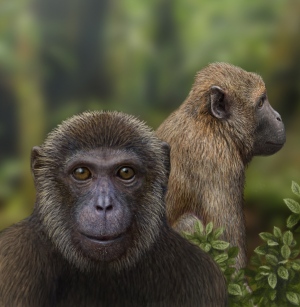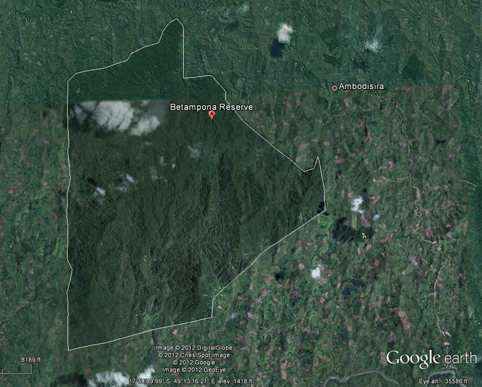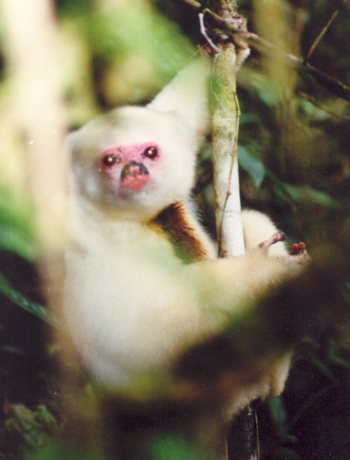Guest post by Joseph Kirollos, NC School of Science and Math
Walking up to the Trent Semans Center at Duke University to interview Dr. Daniel O. Schmitt, professor of Evolutionary Anthropology and teacher of anatomy at Duke University, I couldn’t help but wonder why he would pursue seemingly unrelated interests. On one hand, he studies the locomotion and evolution of primates while at the same time, he but he also has a strong clinical interest in both human functional anatomy and osteoarthritis.

Dan Schmitt with his wife, Christine Wall, who is also an evolutionary anthropologist at Duke. (Duke Chronicle photo)
How did these interests come about? Which came first? These were the questions that ran through my head as I read through his papers and prepared for the interview. Though as Dr. Schmitt sat down and began to tell his story, it didn’t take long for all of my doubts and confusions to quickly fade away. Everything began to blend, and it all made sense.
As it turns out, Dr. Schmitt was actually a latecomer to clinical research and it was through natural variance and human evolution that science first captivated his interest. Although he was somewhat of a “terrible college student,” he quickly developed a genuine curiosity in the vast physical differences between species. It was later during his graduate studies at SUNY Stony Brook, where he worked with live animals, that he became a post-doc drill associate in anatomy and began to wonder how factors such as leg design, pelvis width, or even high metabolism affected how humans and animals move. By asking these questions, he expanded his interests to the next level and created a stepping stone that would lead him into both his evolutionary and clinical research.
[youtube http://www.youtube.com/watch?v=VA8diXNvffY?rel=0]
At the locomotion lab at Duke University, where he continues to research today, he was able to delve headfirst into Evolutionary Anthropology as he studied the selecting factors that govern limb design, gait mechanisms, and energy efficiency of locomotion in primates and humans. One of his main interests even today is the origin of human’s unique design and bipedal locomotion.

Schmitt, who teaches anatomy to medical students, went to the Duke-NUS graduate medical school in Singapore in 2012 to talk about medical education with colleagues. (Duke-NUS)
In fact, the first of his papers that caught my attention dealt with this very topic. It was a paper refuting the commonly accepted theory that humans evolved from terrestrial knuckle-walking primates such as gorillas and chimpanzees rather than tree-climbing ancestors (see the paper here). As I discussed the paper with Dr. Schmitt, he revealed that he normally preferred to avoid controversy, yet, in this case, he felt that he couldn’t “buy into” the fact that humans would evolve from terrestrial knuckle-walking ancestors. He said, “I couldn’t think of one good reason for them to stand up.” Interestingly, the paper analyzes features from the human wrist that previously supported knuckle-walking ancestors and turns it around and says that in fact these features actually may support that we had tree-climbing ancestors. However, in person, Dr. Schmitt referred to this argument as being rather “nihilistic” as it challenges an idea but doesn’t really propose an alternative.
Of course, it was only a matter of time before these interests in both human anatomy and the evolution of biomechanics in primates naturally brought him to wonder how human joints have so uniquely and efficiently adapted. Working with Dr. Ershela Sims, he has studied osteoarthritis in humans, a debilitating and widespread disease of the joints, and today he still explores the factors that cause it.
I found this quite interesting as my family has a long history with severe osteoarthritis. Interestingly Dr. Schmitt said that it was not intervention and treatment that he cared about, but rather he was interested in the basic science, the deeper causes that lead to osteoarthritis. Is there more than just obesity and wear and tear that leads to osteoarthritis and how does it affect human movement? These were the questions that he would ask. Naturally this blended quite well with his gait studies with primates as osteoarthritis affects the gait mechanisms and energy efficiency of humans. So by the time our discussion had finished, I felt a little dumb that I previously felt as though Dr. Schmitt had an unusual range of interests. I realize now that they blend in perfect harmony, each inspiring the other, leading to amazing discoveries.
Joseph Kirollos interviewed Dan Schmitt and wrote this post as part of a Science Communication seminar led by NCSSM Dean of Science Amy Sheck.














